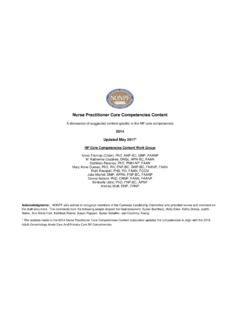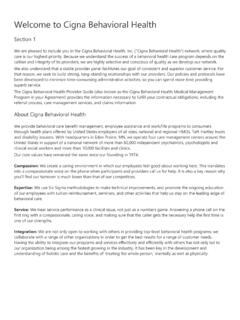Transcription of A guide to quality improvement tools - HQIP
1 Copyright HQIP 2020A guide to quality improvement toolsDecember 2020A guide to quality improvement tools2 Decmbr 20 CoentsIeduduie032 Ppeomefi3f 2ore2qb mapqploeomm yContentsIntroduction 3 Purpose 3 Definition of quality 3 Definition of healthcare quality improvement 3 Involving people in quality improvement 4 quality improvement collaboratives 5 Directory of tools for quality improvement 6 Clinical audit 7 Statistical process control 9 Performance benchmarking 11 Process mapping 13 Root cause analysis 15 Model for improvement 17 Plan do study act 19 Lean/Six sigma 21 Technological innovations 23 Decision trees 25 Communication tools 27 Further reading list and references 29-30 Author: Sally Fereday Researcher: Nicola MalbonAcknowledgements: The National quality improvement Clinical Audit Network (NQICAN) and the HQIP Service User Network (SUN) for consultation on this document 2020 Healthcare quality improvement Partnership Ltd (HQIP)Design: Pad Creative NO 978-1-907561-05-4 Update 2020:Ian Woolhouse, HQIPKim Rezel, HQIPF irst published.
2 June 2015 3 Decmbr 20 CoentsIeduduie032 Ppeomefi3f 2ore2qb mapqploeomm yPurposeThe purpose of this guidance is to signpost those working within, leading, commissioning and using healthcare services to a broad range of quality improvement tools . It should be especially useful to those putting together quality improvement guidance introduces a variety of quality improvement tools used in healthcare and presents case examples and associated tools available to assist with implementation. Definition of quality Much of the current thinking that defines quality in the NHS was set out in High quality care for all: NHS next stage review ,1 led by Lord Darzi.
3 It set out the following three dimensions (figure 1) which must all be present to provide a high quality service: Clinical effectiveness: quality care is care which is delivered according to the best evidence as to what is clinically effective in improving an individual s health outcomes Patient safety: quality care is care which is delivered so as to avoid all avoidable harm and risks to the individual s safety Patient experience: quality care is care which looks to give the individual as positive an experience of receiving and recovering from the care as possible, including being treated according to what that individual wants or needs and with compassion, dignity and respectDefinition of healthcare quality improvementThere is no single definition of quality improvement within healthcare.
4 In general, the term quality improvement refers to the systematic use of methods and tools to try to continuously improve quality of care and outcomes for components include: Understanding the complex healthcare environment Applying a systematic approach Designing, testing and implementing changes using real time Measurement for improvementThere is no clear evidence that one approach is superior to others. Rather, it is the process of having a systematic approach to quality improvement and applying this consistently that is Department of Health, 2008. High quality care for all: NHS next stage reviewFigure 1.
5 Definition of quality Clinical effectivenessPatientsafetyPatientexperie nce4 Decmbr 20 CoentsIeduduie032 Ppeomefi3f 2ore2qb mapqploeomm yInvolving people in quality improvementThose experiencing healthcare systems first hand can provide insightful feedback on the quality of services and how they might be improved. They can also provide useful personal perspectives which should be s input into service design is essential as only they have experience as service users. The involvement of people and communities in healthcare quality improvement can take many forms, for example: Representation at organisational quality committees Shadowing their journey to identify quality shortfalls Leading assessments of the health and care environment Completion of satisfaction surveys Involvement of people and communities to review the information materials that are provided to them Networking to share self-care strategies Analysis of complaints, concerns and claims People and community involvement in quality improvement focus groupsFigure 2.
6 Capturing people and community experiences for insight and perspectiveExperienceInsightPerspectiveF urther information (full reading list on page 29): HQIP, patient and public involvement in clinical auditi HQIP, a guide to develop a patient panel in clinical auditii NHS improvement , Patient experience framework, June 2018iii NHS Institute for Innovation and improvement : The experience based design (EBD) approach, July 2017 - iv NHS England, Patient-led assessments of the care environment (PLACE)v5 Decmbr 20 CoentsIeduduie032 Ppeomefi3f 2ore2qb mapqploeomm yQuality improvement collaborativesQuality improvement collaboratives involve groups ofprofessionals coming together, either from within anorganisation or across multiple organisations, to learn fromand motivate each other to improve the quality of healthservices.
7 Collaboratives often use a structured approach,such as setting targets and undertaking rapid cyclesof most common model for improvement collaboratives is the Breakthrough Series approach developed by the US Institute of Healthcare improvement . A Breakthrough Series is a short term (6 to 15months) learning system that brings together teams from hospitals or clinics to seek improvement in a focused topic area. The driving vision behind the Breakthrough Series is that sound science exists on the basis of which the costs and outcomes of current healthcare practices can be greatly elements of an improvement collaborative include: Topic selection Faculty recruitment Enrolment of participating organisations and teams Learning sessions Action periods The model for improvement Summative workshops Measurement and evaluationThe quality improvement tools employed within improvement collaboratives are described in more detail in the next section.
8 Figure 3: Collaboration for quality improvementFurther information (full reading list on page 29): IHI breakthrough collaborative seriesi NHS Improving quality , Patient safety collaborativesiiCollaborativequalityimpr ovement6 Decmbr 20 CoentsIeduduie032 Ppeomefi3f 2ore2qb mapqploeomm yDirectory of tools for quality improvementThis next section illustrates a number of tools for quality improvement . A combination of tools is required for successful completion of a quality improvement project. A common pitfall is to move straight to testing new ways of working without spending sufficient time understanding the cause of the to measure care against agreed standardsPageClinical auditChecks clinical care meets defined quality standards7 Statistical process controlMeasures quality within predefined parameters9 Performance benchmarkingMeasures quality against peers or national targets11 tools to understand the cause of the problemPageProcess mappingMaps the patient journey for quality improvement opportunities13 Root cause analysisSystematically uncovers the causes of events
9 Affecting quality15 tools to plan and test improvement projectsPageModel for improvementDecides upon, test and refines quality improvements17 Plan do study actIntroduces and tests potential quality improvements on a small scale19 Lean six sigmaEliminates waste and redirects resources for quality and efficiency21 tools to promote change in practicePageTechnological innovationsAutomates processes and systems for care quality improvement23 Decision treesImproves the quality and consistency of processes in healthcare25 Communication toolsImproves quality of care through structured information exchange277 Decmbr 20 CoentsIeduduie032 Ppeomefi3f 2ore2qb mapqploeomm yClinical auditUse to.
10 Most effective:Prerequisites:Overview:How to use it:2. Burgess, R. (ed), 2011. New Principles of Best Practice in Clinical Audit. 2nd ed. Radcliffe Publishing LimitedCheck clinical care meets defined quality standards and monitor improvements to address shortfalls ensuring compliance with specific clinical standards and driving clinical care improvement . Evidence based clinical standards drawn from best practice and an audit proforma comprised of measures derived from the standards. A clearly defined population of patients (or a sample from the population) whose care will be measured using the pro audit can be described as a quality improvement cycle that involves measurement of the effectiveness of healthcare against agreed and proven standards for high quality , and taking action to bring practice in line with these standards so as to improve the quality of care and health check clinical care provided against specific desired standards, clinical audit typically involves the design of a clinical audit pro forma comprising those standards, and the subsequent review of a defined sample of healthcare data, such as health records, using thi










